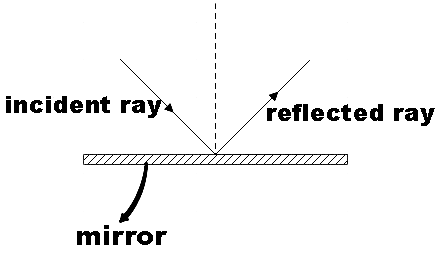
The ray of light which falls on a mirror is called
A. Reflected ray
B. Emergent ray
C. Incident ray
D. Transmitted ray
Answer
558.9k+ views
Hint: In order to answer this question, we could recall the definitions of each of the given options. This is a pretty simple question if you have a basic idea of the process of reflection and refracted. Now you could cross check the given definition with the recalled definitions of the given options and hence find the answer.
Complete step by step answer:
In the question we are given names of 4 rays and are asked to identify which among those rays represents the ray of light that falls on a mirror.
In order to answer this, let us recall the definitions of each of the given rays.
Firstly, we have the reflected ray. The ray of light that gets reflected by the reflecting surface (for e.g., a mirror) or we could say that it is the ray that is seen to bounce off a reflecting surface.
Secondly, we have the emergent ray which is defined as the ray that emerges out of a second medium back to its original medium.
Next we have the incident ray, which is defined as the ray that falls on the reflecting or refracting surface.

Then we have the transmitted ray which is the ray that is transmitted into a second medium by getting refracted.
Now that we have discussed the definitions of all of the given options, we see that it is the incident ray that falls on a mirror.
So, the correct answer is “Option C”.
Note: For the case of reflection, we have three laws. They are:
(1) The normal to the reflecting surface at the point of incidence, the incident ray and the reflected ray, all the three lie on the plane.
(2) The angle of incidence, angle made by the incident ray with the normal is equal to the angle of reflection, the angle made by the reflected ray with the normal.
(3) The incident ray and the reflected ray lie on either side of the normal.
Complete step by step answer:
In the question we are given names of 4 rays and are asked to identify which among those rays represents the ray of light that falls on a mirror.
In order to answer this, let us recall the definitions of each of the given rays.
Firstly, we have the reflected ray. The ray of light that gets reflected by the reflecting surface (for e.g., a mirror) or we could say that it is the ray that is seen to bounce off a reflecting surface.
Secondly, we have the emergent ray which is defined as the ray that emerges out of a second medium back to its original medium.
Next we have the incident ray, which is defined as the ray that falls on the reflecting or refracting surface.

Then we have the transmitted ray which is the ray that is transmitted into a second medium by getting refracted.
Now that we have discussed the definitions of all of the given options, we see that it is the incident ray that falls on a mirror.
So, the correct answer is “Option C”.
Note: For the case of reflection, we have three laws. They are:
(1) The normal to the reflecting surface at the point of incidence, the incident ray and the reflected ray, all the three lie on the plane.
(2) The angle of incidence, angle made by the incident ray with the normal is equal to the angle of reflection, the angle made by the reflected ray with the normal.
(3) The incident ray and the reflected ray lie on either side of the normal.
Recently Updated Pages
Master Class 12 English: Engaging Questions & Answers for Success

Master Class 12 Economics: Engaging Questions & Answers for Success

Master Class 12 Social Science: Engaging Questions & Answers for Success

Master Class 12 Maths: Engaging Questions & Answers for Success

Master Class 12 Chemistry: Engaging Questions & Answers for Success

Master Class 12 Business Studies: Engaging Questions & Answers for Success

Trending doubts
What are the major means of transport Explain each class 12 social science CBSE

Which are the Top 10 Largest Countries of the World?

Draw a labelled sketch of the human eye class 12 physics CBSE

Explain sex determination in humans with line diag class 12 biology CBSE

The pH of the pancreatic juice is A 64 B 86 C 120 D class 12 biology CBSE

Explain sex determination in humans with the help of class 12 biology CBSE




